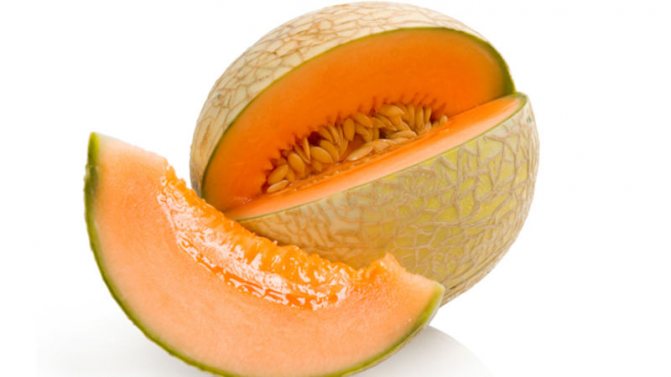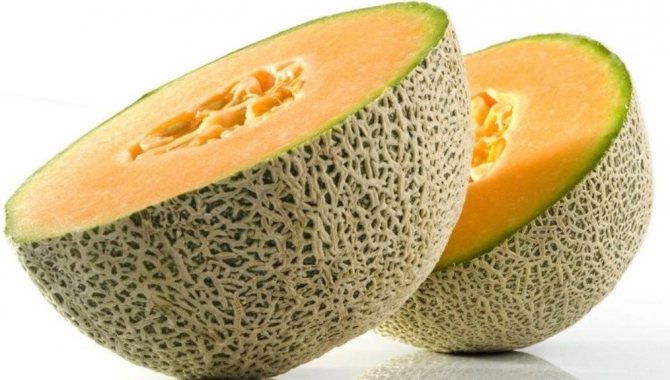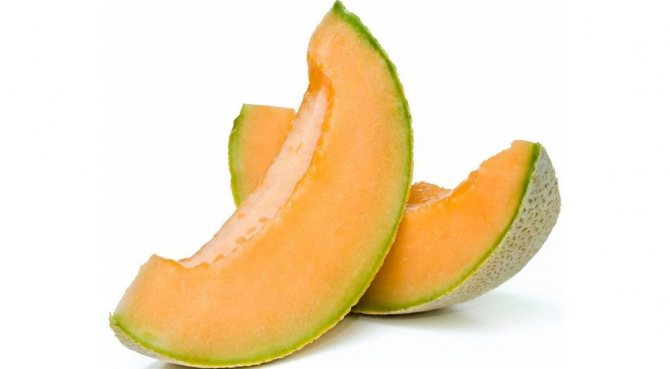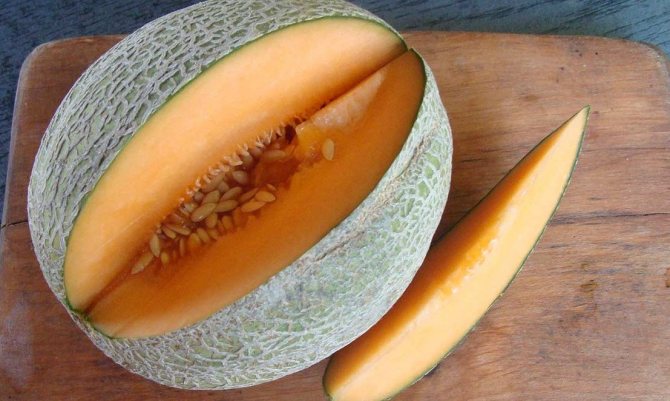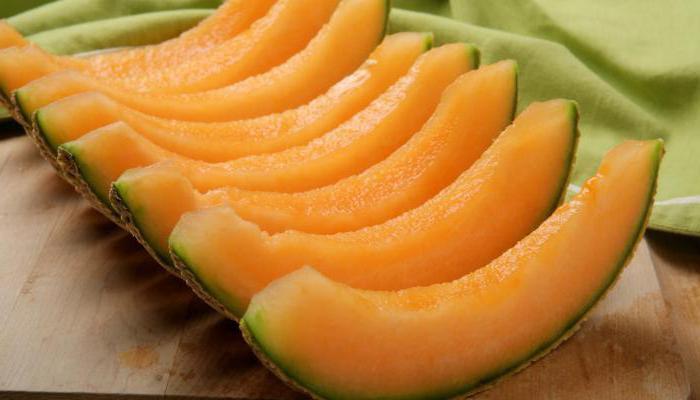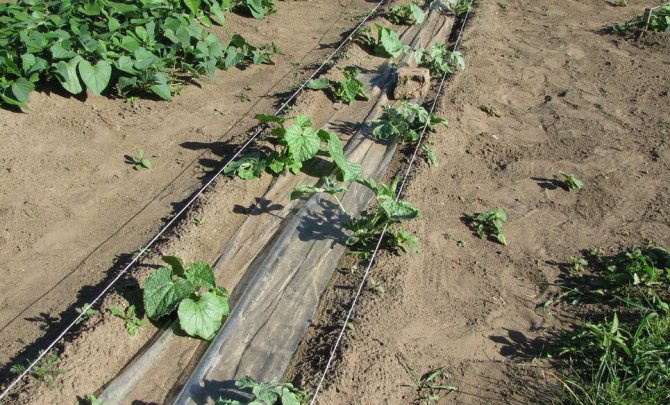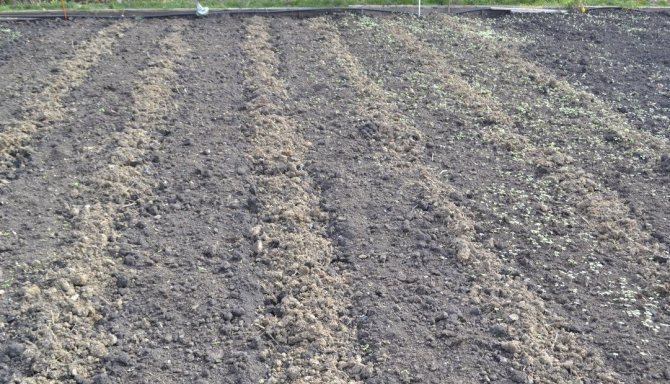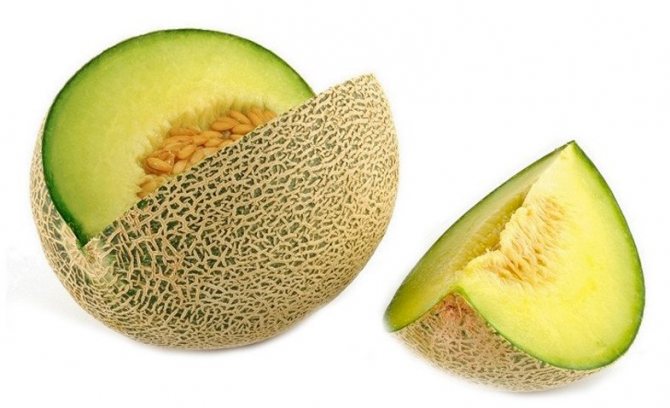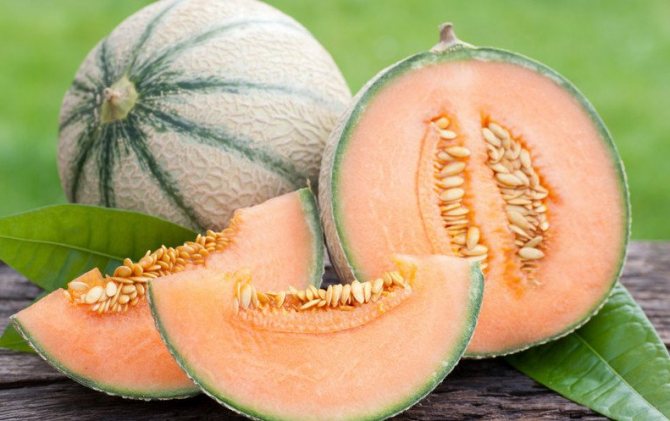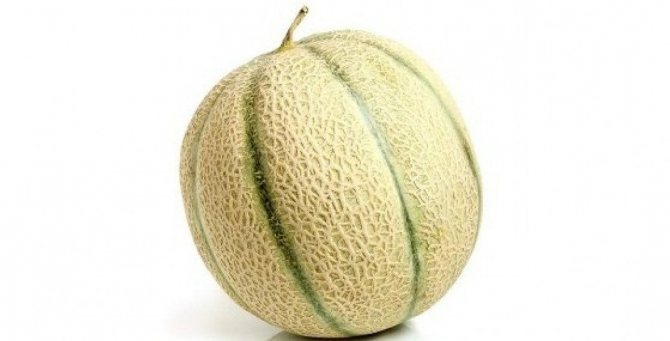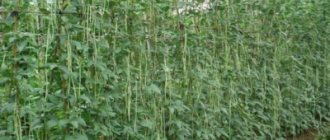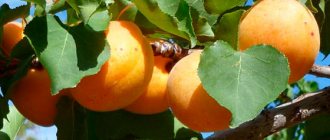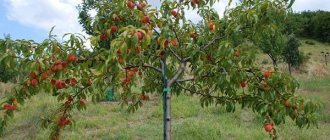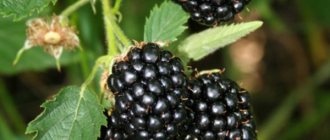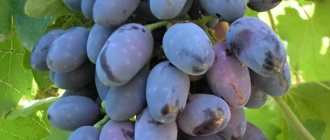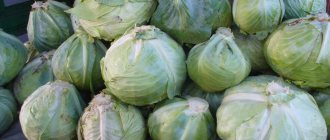Melon cantaloupe: description and characteristics
Melon Cantaloupe, also known as musk or Thai, is a pumpkin vegetable that belongs to the cucumber family. It is grown in European countries and in the USA; it is not so widespread in the territory of the Russian Federation.
The external signs of the fruits of this variety are as follows:
- stems are powerful and branched, located on the ground;
- the leaves are larger in size than most of the "brothers", have a rigid plate and a dark green color;
- the shape is oval, round or flattened - depends on the conditions of planting and growing, the hybrid variety used;
- the skin is either smooth, or rough, or segmented with a mesh;
- the color of the peel is bright yellow or orange. There is also a light green tint, but rarely;
- the pulp tastes like a sweet musky aroma, is saturated with juice, but at the same time remains tender. Color - orange or dark yellow. Occasionally - soft cream;
- the size of one fruit does not exceed 30-35 centimeters with an average of 20-25 centimeters. Weight - from half a kilo to 1.8 kilograms;
- the variety belongs to the mid-season, therefore, with a spring planting, the crop can be harvested by the end of the years. There are early maturing hybrids.
Due to its unpretentious care and resistance to most pathogens or pests, Cantaloupe melon can be grown both in southern latitudes and in the climate of the middle zone.
Gardeners reviews
★★★★★
Elena, 45 years old. I didn’t believe that southern melons would grow in our climatic conditions. But, despite my skepticism, I was pleased with the Cantaloupe variety. I planted seedlings in peat cups. Germination rate was approximately 90%. By the time of planting in the ground, about 20 days, there were already 4-5 leaves on the shoots. Care during the summer consisted of forming bushes, loosening and watering on very hot days. The first melon ripened in mid-August and delighted with its sweet taste and aroma.
★★★★★
Ivan, 55 years old. Every year we plant something special in the garden. In the past, they decided to plant melons. The choice fell on the Cantaloupe variety. They were planted immediately in open ground under a film shelter. The sprouts formed well, but here we made one mistake - it became a pity to pinch them. As a result, there was a lot of ovary, but the fruits did not have time to ripen.
Hide
Add your review
Melon Cantaloupe has a delicate musky aroma and delicate flesh. The variety, although it is southern, grows well and bears fruit in a cool climate. Care for the growth period consists in loosening the soil, forming bushes and ovaries, weeding, timely fertilization and watering. Ripe melons can be stored for up to 2.5 months.
0
Pros and cons of culture
The positive qualities of the melon include:
- due to the dense skin, the risk of excessive moisture loss is eliminated, which avoids the appearance of cracks in the fruits and deterioration of taste. Melons can also be transported without unnecessary complications;
- cantaloupe tolerates high humidity and low temperatures, which positively distinguishes it from other melon varieties;
- relatively short ripening times for melons - an average of 80 days;
- pleasant taste;
- melon resistance to powdery mildew is maintained even without pretreatment.
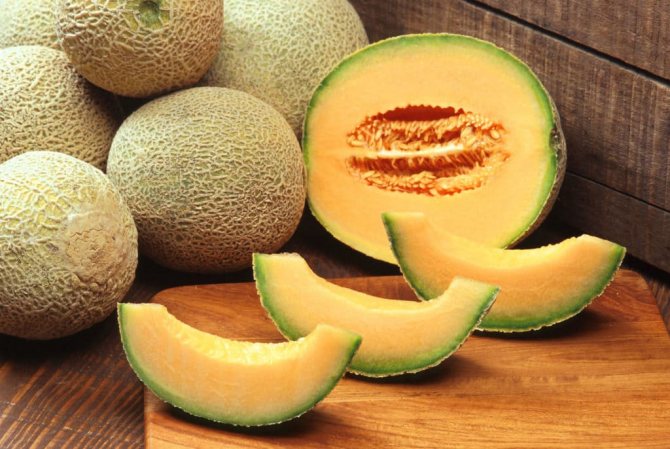
As for the disadvantages:
- because of too tender and juicy pulp, the fruits cannot be stored for a long time. The shelf life does not exceed 2 months;
- vegetable crops require additional watering if hot weather persists for more than a week;
- the small size of the fruit, which is not always considered a disadvantage.
Additionally, it should be borne in mind that the pulp of Cantaloupe melon contains a lot of sugar. Therefore, people with diabetes mellitus, diarrhea or similar prohibitions will have to refuse its use.
Origin
Unlike other varieties, Cantaloupe has a bright orange pulp, more like a pumpkin
It is believed that the birthplace of the melon Cantaloupe is Western Europe. In fact, this melon, taken from the territory of Armenia by Catholic monks, was presented as an unusual dish to the Pope in the 15th century.
The pontiff liked the treat, and he ordered the cultivation of such melons in the Italian province of Cantaluppia, which is where the name of this variety came from.
Over time, Cantaloupe spread throughout Europe and America, and today this melon is equally popular in both the Old and New Worlds.
In Russia, Cantaloupe is undeservedly forgotten, although before the revolution in our country its special varieties were bred, for example, Moscow Cantalupa.
Useful properties of a vegetable
Due to the chemical composition, the fruits can be beneficial to the body:
- fiber helps to normalize the functioning of the digestive system;
- high sucrose content ensures the functioning of the liver, brain and nervous system;
- vitamin C helps the immune system build additional protection against pathogens;
- silicon is required for a developing organism, because it is involved in the formation of bone tissue;
- carotene has a beneficial effect on the skin;
- choline is recommended for use during pregnancy;
- zeaxanthin prevents the appearance of disturbances in the work of the cardiovascular system;
- potassium helps to eliminate problems with blood pressure;
- iron strengthens the body and resists the occurrence of anemia.
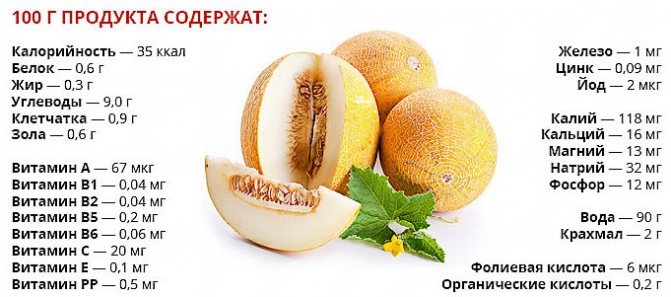

Melon Cantaloupe can be used when building methods for losing excess weight, because 100 grams of pulp contains only 34 kcal.
How to choose a ripe melon when buying
There are four main ways to choose a fruit and berry crop:
- The appearance of the fetus. Integrity, no cracks or dents under which decay can begin. The skin of the fruit is free of plaque (checked with a fingernail), uniform color and texture. Green spots mean the cantaloupe was harvested immature.
- Fruit smell. The aroma of a quality melon is pleasant, fragrant. Melon is clearly felt in it, and a little more pear, vanilla or pineapple (depending on perception and on the type of fruit). Low-quality fruit is often odorless.
- Impact sound. If it is easy to hit the surface of the melon, then the sound should be muffled (unlike a watermelon).
- Fruit tail. It should be plump, peelable and completely dry.
When buying, the listed methods must be combined, you should not be limited to one sign. Then the purchased cantaloupe is guaranteed to be tasty and healthy.
Cooking applications
Melon is usually eaten raw. However, the fruits can also be used in cooking:
- dried melon. Serves as a substitute for artificial desserts. Retains useful vitamins and minerals: folic acid, retinol, ascorbic acid, etc.;
- dried. Used as a pie filling or sweetener. Can be added to compotes and yoghurts for flavor enhancement. Available on store shelves, but it is also allowed to do it yourself. To do this, cut the fruit into small pieces and place in the open sun to dry;
- candied melon. They differ in taste and a large number of useful microelements, including beta-carotene and sucrose. In this regard, it is used as a sugar substitute;
- vegetable and fruit salads.Melon can be used in combination with many different cultures.
See also Gulabi melon variety: planting and cultivation features
In addition, jams, various desserts, pastries, etc. are made from melons.
The chemical composition of the fetus
It is appreciated not only for its taste, but also for its useful properties. According to certain indicators, for Cantaloupe there is no equal among other fruits. Most of all it contains:
- ascorbic acid;
- carotene;
- inosine;
- fiber;
- silicon.
For example, it contains the most carotene, a lot of sucrose. Cantaloupe has a higher sugar level than watermelon.
The presence of iron in cantaloupe is almost twice as high as chicken meat and seventeen times higher than milk. The presence of vitamin C is also highlighted, which is three times ahead of watermelon in its quantity.
Cantaloupe is recommended for those suffering from obesity, cholesterol, hair loss. The presence of Inosine in the product prevents such diseases from progressing.
The potassium present in the berry stabilizes blood pressure, so that the fruit can be eaten by hypertensive patients. The low calorie content of the fetus allows it to be included in the diet.
Melon peel is used in the preparation of nourishing masks for the skin of the face.
The sweetest and best varieties
There are several popular melon hybrid varieties, including:
- Charente. Grown by French breeders. The size of the fruit does not exceed 15 centimeters in diameter with a weight of 600 grams to 1.2 kilograms. Differs in strong aroma and pleasant taste;
- Yellow. Weight can reach a record 1.5-1.8 kilograms. The pulp is orange in color with shades of green, saturated with juice and giving off a persistent aroma. The shape of the fruit is round, the skin has a pronounced relief;
- White. An early ripening variety, ripens in 2 months. The fruit is round with a smooth skin. Weight can reach 1.8 kilograms. The pulp is distinguished by a predominant shade of green and a pronounced sweet taste;
- Kasaba. Has almost no aroma. The color of the flesh is white, the color of the skin is pale yellow. Late ripening - you can see it on store shelves closer to October.
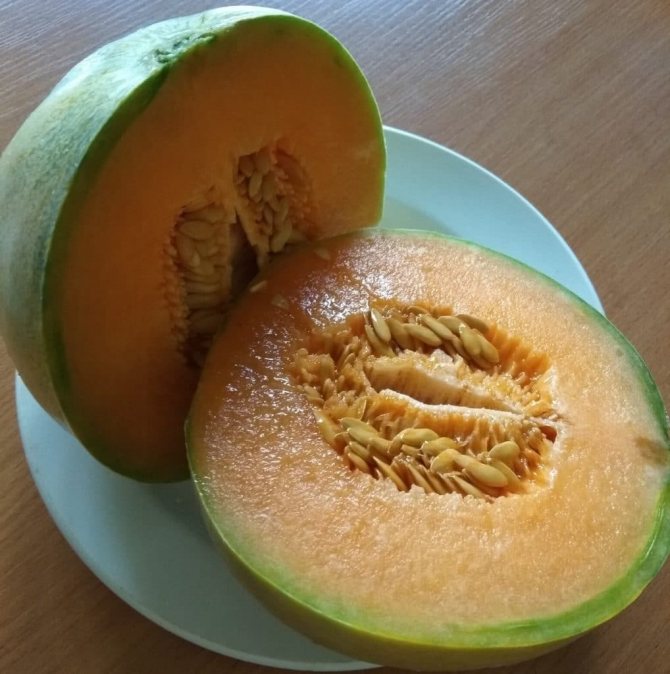

Charente
There are other varieties of melon: Oksana, grown by Russian breeders, or Gallia, bred by Israeli scientists, Blondie, Iroquois and others - they are all similar, but still have distinctive features.
Breeding history
The first mentions of Cantalupe appeared more than 2 thousand years ago. Information about this plant is found in the historical documents of Guinea and India. However, the culture became more widespread in Western Europe.
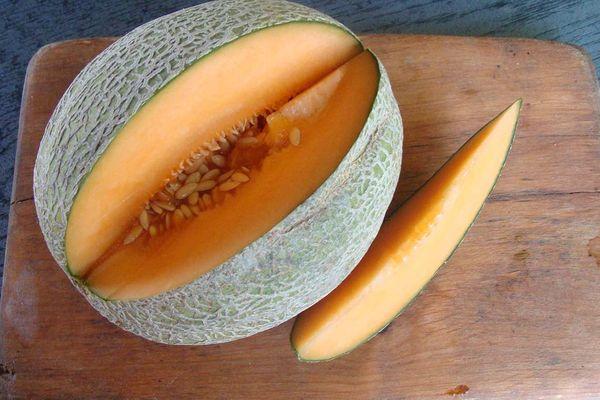

Today, cantaloupe is found almost all over the world. She came to Russia from Italy, where the plant is valued for its refined taste. Many varieties have spread from Italy. One of them is the Kasaba variety, which has white flesh.
Cantaloupe has become widespread due to its unpretentiousness. Fluid deficiency does not create obstacles throughout the season. Culinary experts often add the berry to their dishes as it has a good aroma and great taste.
Features of growing in the open field
Despite the fact that the Cantaloupe melon is considered unpretentious in care, in order to obtain a high-quality harvest, it is necessary to take into account the peculiarities of growing a crop outside of greenhouse conditions.
Site preparation
First of all, you need to prepare the site. To do this, it is important to follow a number of rules:
- good performance can be achieved by planting melon seeds in loamy and sandy soils, the acidity of which is about 6;
- because of the spreading stems, a large bed is required;
- the plant is considered light-loving, but does not tolerate the wind too much. Therefore, it is worth choosing the southern part of the site on the slope;
- unfavorable neighbors in the garden for the melon - potatoes and beets. It is best to plant the melon next to leafy crops;
- the presence of drainage is a must, since it is important to avoid stagnation of water in the aisles of the melon;
- re-growing at the site where Cantaloupe was planted last season is not recommended for 5 years.
Having chosen a suitable land, you need:
- Dig the soil to a depth of 30 centimeters. Remove stones, branches and other unnecessary items.
- Warm up the soil to 18 degrees, placing a film on the bed in April.
- We'll have to feed the soil. One square meter should account for 3 kilograms of humus, or twice as much manure.
Important. Immediately before planting the Cantaloupe melon, you need to re-dig and loosen the soil.
Landing dates and schemes
When choosing a seed for Cantaloupe melon, you need to take into account the climatic conditions in the region of residence:
- most of the culture representatives require at least 2 hot months for the fruits to ripen. However, there are hybrids for cool summers.
- for regions with a short summer, it is worth choosing early varieties. Southerners can use mid- and late-ripening varieties;
- seeds should be planted on seedlings in early April. Planting in the soil is carried out after 1.5 months. It is also allowed to sow directly into open ground - for this you need to wait until the last days of May.
When planting seed you need:
- Prepare the wells. To do this, the bed should be divided into rows every 130-140 centimeters. The depth of the hole is no more than 5 centimeters. The distance between them is 80-85 centimeters.
- Plant melon seeds. In one recess - 3-4 pieces.
- Close up the holes. Gently cover with soil, creating small mounds.
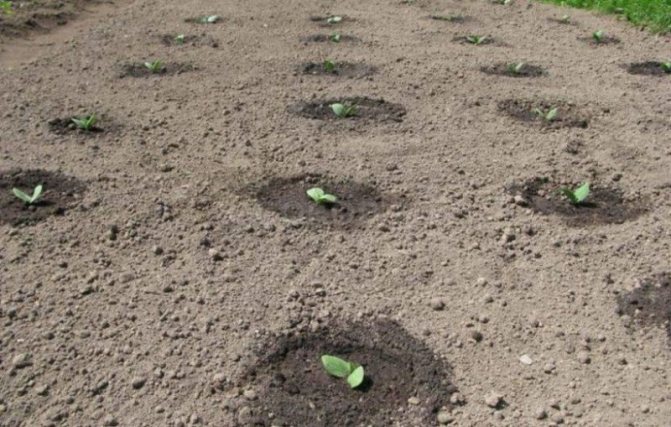

If the spring weather does not please with the sun, then the gardener should prepare for planting seedlings in advance.
Watering
The peculiarities of watering are largely determined by weather conditions and the stage of growth. The rules are as follows:
- regardless of the circumstances, it is important to avoid drying out or excessive moisture in the soil;
- while maintaining hot weather, you need to water the melon every morning and evening - at least 4 liters of water under one bush;
- with constant clouds, it is necessary to reduce the frequency of soil moistening to once a day, and the volume to 3 liters;
- in the rains, watering the melon will have to be abandoned;
- the water temperature should not be less than 22 degrees;
- the distance to the root collar is 5-7 centimeters. In this way, the risks of decay can be avoided.
See also Melon Torpedo: benefits and harms for male and female health
Watering stops completely one week before harvest.
Top dressing
You need to fertilize the melon throughout the growth stage:
- The first feeding must be carried out using mineral complexes, when the first shoots sprout and leaves appear on them.
- The second time - one and a half weeks after the first. Melon fertilization should be done with a solution of rotted compost at the rate of 3 kilograms per 10 liters.
- The third top dressing is nitrogen. It is carried out 10 days after the second.
- The next one is after two weeks. You will need to prepare a solution of water and wood ash in a ratio of 3 to 1. For each bush you need at least 1.5 liters.
- The last fertilization is carried out after 2-3 weeks and is an organic fertilization from humus (3 kilograms of substance per 10 liters of water).
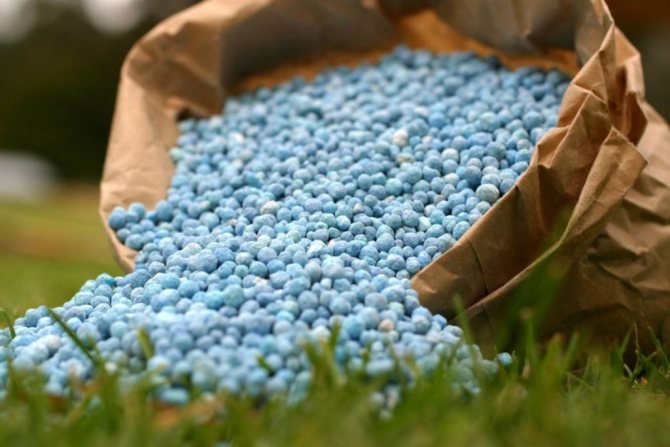

Nitrogen fertilizers
The use of reinforcing components is also allowed when forming the ovaries. This will require 20 grams of superphosphate, 5 grams of nitrate and 8 grams of potassium chloride. All this must be diluted in 5 liters of water and the plant must be treated.
Formation of bushes
To save the plant the strength for the development of the stems and send them to the formation of fruits, you need to correctly form the bushes. This will require:
- Install a film shelter when disembarking.
- Remove it as the culture begins to bloom.
- Pinch the main stem at the level of the fourth leaf.
- Select two strong side shoots and attach to the ground.
- The remaining shoots should be shortened to 5 leaves.
An additional method involves the establishment of a frame structure.
Loosening and mulching the soil
After planting the seed, you need to loosen the soil at least once a week, observing the requirements for depth - 5 centimeters. When the plant begins to bloom, you will need to reduce the amount to once every 10-12 days, but increase the depth to 10 centimeters.


Together with loosening, it is necessary to weed the melon from weeds. To avoid the risk of damage to the root system, unwanted plants should be carefully removed from the soil.
Expert opinion
Stanislav Pavlovich
Gardener with 17 years of experience and our expert
Ask a Question
Important. In addition, it is required to carry out hilling after the emergence of side shoots and to use mulch in the aisles to prevent fruit rot.
Diseases and pests: treatment and prevention
Despite its resistance to disease, melon can still suffer:
- to get rid of aphids, you need to use insecticides. Preliminary measures - treat with a solution of laundry soap;
- spider mites can only be killed when the affected fruits are removed;
- if downy mildew is observed, a fungicide may help. Prevention is to tie up the melon;
- when melon decays, you need to reduce the amount of watering, and pour mulch in the aisle.
Expert opinion
Stanislav Pavlovich
Gardener with 17 years of experience and our expert
Ask a Question
Important. It is not always possible to cope with pests or diseases. If the plant is affected by nematodes or mycosperella rot, the crop will not be obtained. The only thing that remains is to treat the land with chemicals before the next planting.
Possible problems
There are usually no problems with Cantaloupe. But sometimes it can be affected by diseases, pests and bear poor fruit.
Melons grown in cultivation are more susceptible to pests and diseases.
Diseases
Diseases, their signs and methods of treatment:
- Downy mildew. It is manifested by the appearance of yellow spots on the leaves. A fungicide such as chlorothalonil will help fix the problem. Tie up the melons to prevent the spread of disease.
- Mycosperellus rot. The stems break, a yellow-orange liquid flows from the fractures. The crop, most likely, will not be able to be harvested. After harvesting, treat the field with fungicide. The next year, plant another crop on this site.
- Sclerocial southern rot. Melons rot after rain. Heavy soil is often the cause. Reduce the amount of watering and add mulch between the rows. Read more about soil mulching here.
Pests
Melons can be affected by the following pests:
- Nematodes. Nodes appear at the roots, the stems look swollen. Plant rye next year in the melon garden.
- Aphid. Leaves become sticky and wither. Use insecticides like Theodan. You can treat the plants with a mixture of essential oils or laundry soap.
- Mole miner. Gnawed holes appear on the leaves. This insect will not affect the quality of the crop, so there is no need to fight it.
- Spider mite. The leaves turn yellow and become covered with cobwebs. No action is required if the disease is weak. If the defeat is severe, the only way to fight is to get rid of the melons.
Poor fruiting
Melons bear poor fruit for several reasons:
- Cold soil. If the soil is poorly warmed up at the time of planting, only male flowers will form on the melon. Monitor soil temperature before planting.
- There are no pollinating insects. If there are few pollinating insects in the area, or you are growing melons in a greenhouse, manually pollinate them.
If all the care measures are performed correctly, and the melons still do not bear fruit, try sowing rye in the garden 30 days before planting the melons.
Harvesting dates and rules for storing crops
The melon should be picked selectively as it ripens. A melon is considered ripe if it smells good and separates easily from the stalk. The rind is squeezed when pressed.
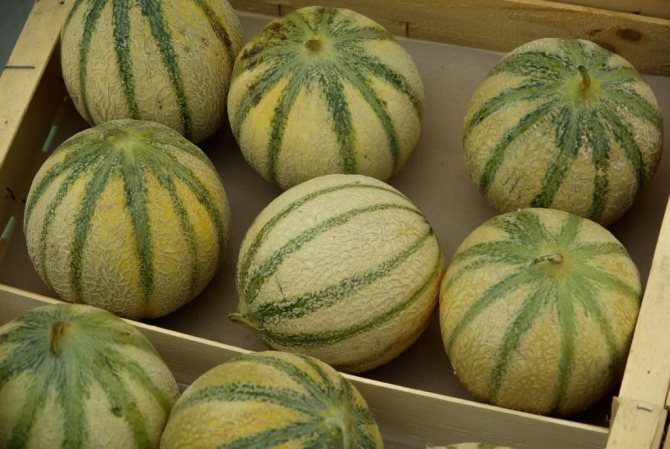

Plucked fruits should be left in the aisle for one to two weeks, turning every four days - this way you can increase the shelf life. Use cotton nets for storage. Melons should be placed in a dark place with a humidity of up to 75% and a temperature of more than 13 degrees.
Care
Cantaloupe loves regular, abundant watering with warm water under the root. During maturation, the amount of moisture is reduced, reducing the frequency of irrigation. The first weeks at night, the ridges are covered, during the day they are opened. Regular weeding and loosening of the soil is required. The stems can be left to crawl on the ground, planks are placed under the formed fruits. Before flowering, following strict instructions, you can feed with nitrogen fertilizer, and then containing phosphorus and potassium. With enough sunny days, the plant will give a bountiful harvest.
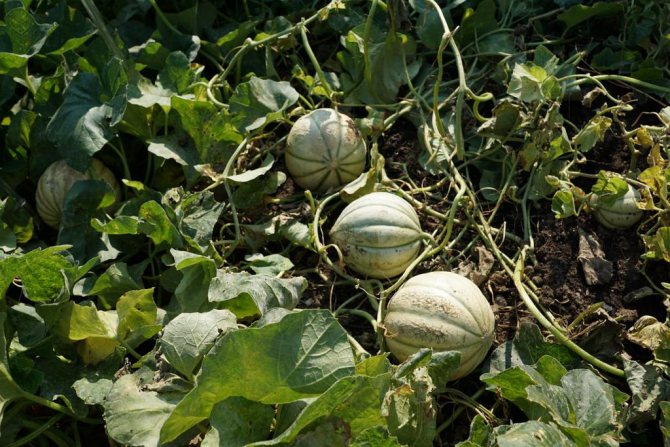

Culinary use
Melon is delicious, refreshing and easy to add to your diet.
It can be diced and used alone or in a delicious fruit salad. It can also be whipped into fresh sorbet for a healthy meal.
Alternatively, you can add melon to salads or smoothies for added flavor and nutritional value.
What's more, you can wash, dry, and roast melon seeds for a delicious snack. Or try sprinkling them with soups and salads.


